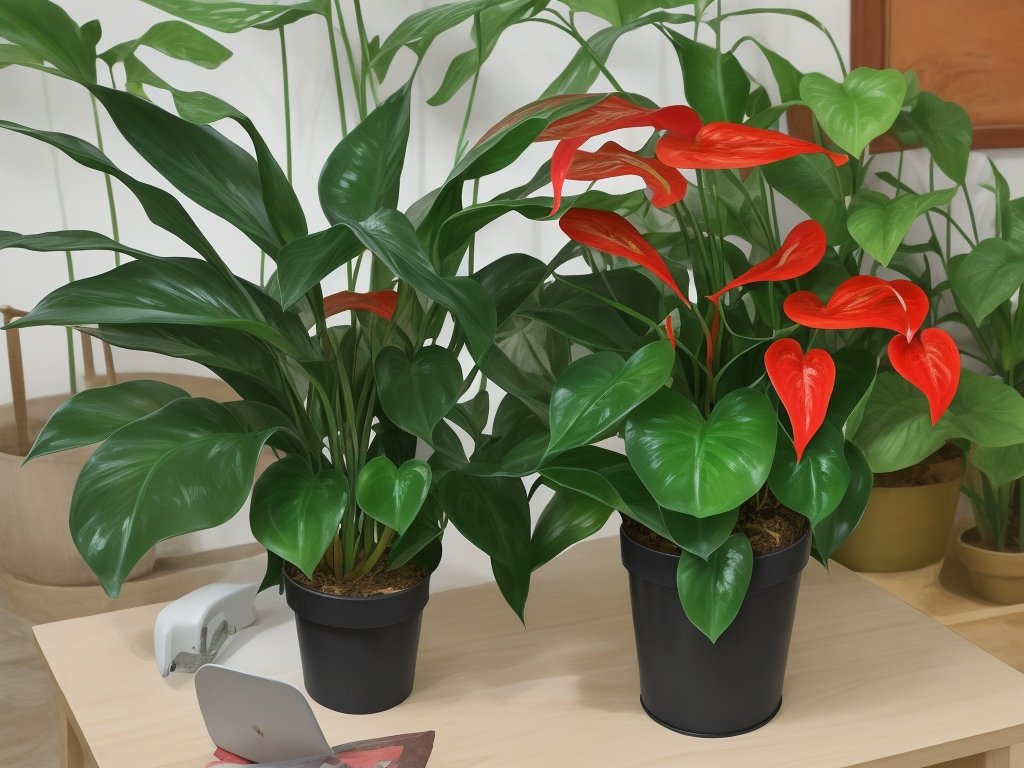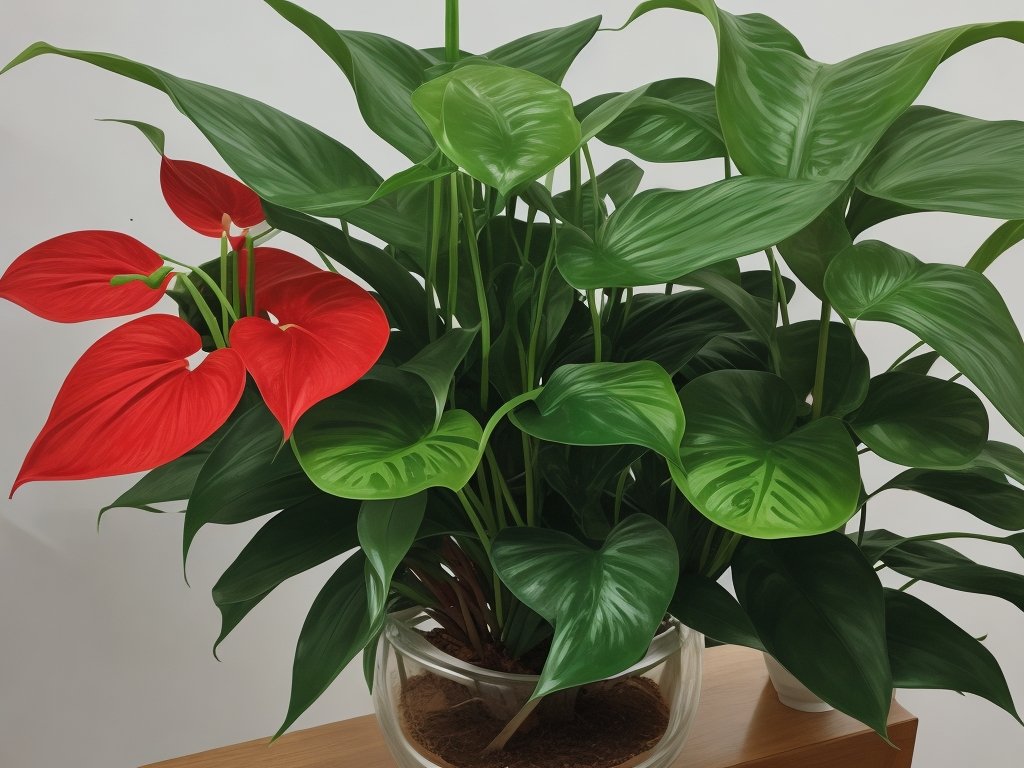Anthurium Bloom Cycle: Nature’s Timeless Beauty!
Key Takeaways:
- Anthurium blooms typically last for 4 to 8 weeks.
- The blooming frequency of anthuriums may vary based on the specific variety.
- Proper care and maintenance can encourage more frequent blooming.
- Anthuriums require a dormant period of 4 to 12 weeks before they can bloom again.
Have you ever been captivated by the stunning beauty of an Anthurium plant in full bloom?
These vibrant and enchanting flowers add a touch of elegance to any space.
But have you ever wondered about the fascinating process behind the Anthurium bloom cycle?
In this blog, I’ll take you on a journey through the different stages of Anthurium bloom, explore the factors that impact this cycle, and provide tips and techniques to promote more frequent and abundant blooms.
Get ready to delve into the world of Anthuriums and uncover the secrets to unlocking their breathtaking blooms.
| Stage | Duration | Characteristics |
| Vegetative Stage | Variable | Continuous leaf growth |
| Inflorescence Development | 1-2 months | Emergence of flower bud |
| Bloom Stage | 2-3 months | Flower fully opens, colorful bract |
| Mature Stage | Variable | Flower remains open, bract color fades |
| Resting Stage | Variable | No active growth or flowering |
What is Anthurium?
Anthurium is a type of tropical plant known for its vibrant, heart-shaped flowers.
Brief introduction to Anthurium plants
Anthurium plants, also known as flamingo flowers or laceleafs, are tropical plants native to Central and South America.
They are characterized by their stunning heart-shaped leaves and colorful spathes, which can come in a variety of vibrant shades like red, pink, or white.
Anthuriums are popular as houseplants due to their exotic beauty and relatively easy care requirements.
Plus, they can add a touch of tropical elegance to any space.

Understanding the Anthurium Bloom Cycle
The Anthurium bloom cycle is important to understand for successful cultivation.
Different stages of Anthurium bloom
Anthurium plants go through three main stages of bloom: budding, flowering, and fading. During the budding stage, small, closed buds form on the plant.
These buds gradually open to reveal striking, vibrant flowers during the flowering stage.
Finally, as the blooms age, they begin to fade, losing their color and eventually wilting. It’s important to enjoy each stage of the Anthurium bloom cycle and appreciate the beauty of the plant at every stage.

Factors Affecting Anthurium Bloom Cycle
Various environmental factors can significantly impact the blooming cycle of Anthurium plants.
Environmental factors that impact Anthurium bloom
The environmental factors that impact Anthurium bloom include:
- Light: Anthuriums require bright, indirect light to thrive. Insufficient light can result in poor blooming or no blooms at all.
- Temperature: Anthuriums prefer temperatures between 65-80°F (18-27°C. Extreme temperatures can stunt growth and hinder blooming.
- Humidity: These plants thrive in high humidity environments. Low humidity can cause their blooms to dry out and wither.
- Air Circulation: Good air circulation prevents the buildup of moisture, reducing the risk of fungal diseases that can affect bloom production.
- Watering: Anthuriums prefer evenly moist soil, but overwatering can lead to root rot and hinder blooming. Proper drainage is crucial.
- Fertilization: Regularly feeding Anthuriums with a balanced fertilizer can promote healthy, vigorous growth and encourage blooming.
By providing the right balance of light, temperature, humidity, air circulation, watering, and fertilizer, you can create an optimal environment for your Anthurium plant to bloom beautifully.

Ideal Environment for Anthurium Bloom
To ensure optimal Anthurium bloom, create a suitable environment with consistent light, moderate humidity, and stable temperatures.
Tips for creating the perfect conditions for Anthurium bloom
Creating the perfect conditions for Anthurium bloom requires attention to a few key factors. Here are some tips to help you out:
- Lighting: Anthuriums thrive in bright, indirect light. Place your plant near a window with filtered sunlight, or provide artificial light if needed.
- Temperature and Humidity: Aim for temperatures between 65-80°F (18-27°C during the day, and slightly cooler at night. Anthuriums prefer high humidity levels, so consider using a humidifier or placing a tray of water near the plant.
- Watering: Keep the soil moist but not waterlogged. Allow the top inch of soil to dry out before watering again. Avoid overwatering, as it can lead to root rot.
- Fertilization: Use a balanced, water-soluble fertilizer formulated for houseplants. Apply according to the label instructions, typically every 2-4 weeks during the growing season.
- Potting and Soil: Use well-draining potting soil that retains some moisture. Repot the plant every 1-2 years, as needed, to prevent the roots from becoming overcrowded.

Length of Anthurium Bloom Cycle
The Anthurium bloom cycle typically lasts for several weeks, but its length can be influenced by various factors.
Average duration of Anthurium bloom and factors that influence it
The average duration of an Anthurium bloom can vary depending on several factors.
Typically, an Anthurium bloom can last anywhere from 4 to 8 weeks.
However, certain factors can influence the duration of the bloom.
These factors include:
- Light intensity: Anthuriums thrive in bright, indirect light. Insufficient light can lead to shorter bloom durations, while proper lighting can help prolong the blooming period.
- Temperature: Anthuriums prefer temperatures between 70-85°F (21-29°C. Extreme temperatures, such as those below 60°F (15°C) or above 90°F (32°C), can cause the blooms to fade more quickly.
- Humidity: These tropical plants appreciate high humidity levels. Dry air can cause the blooms to wilt and shorten their lifespan. Using a humidifier or placing the plant on a tray filled with water and pebbles can help maintain humidity.
- Watering and fertilization: Proper watering and fertilization are essential for healthy blooms. Over or under-watering can stress the plant and lead to shorter blooming periods. Similarly, an inadequate or excessive amount of fertilization can affect bloom duration.
- Plant health: A healthy Anthurium plant is more likely to produce longer-lasting blooms. Regularly checking the plant for pests, diseases, and nutrient deficiencies and addressing them promptly can promote longer bloom durations.
By ensuring optimal growing conditions and attending to the plant’s needs, you can help extend the duration of the Anthurium blooms.
How to Promote Blooms in Anthurium Plants
Want more blooms in your Anthurium plants? Try these tips and techniques!
Tips and techniques to encourage more frequent and abundant blooms
To encourage more frequent and abundant blooms in Anthurium plants, here are some tips and techniques:
- Provide adequate light: Anthuriums thrive in bright, indirect light. Place them near a north or east-facing window for optimal exposure.
- Maintain optimal temperature and humidity: Anthuriums prefer temperatures between 65-80°F (18-26°C and high humidity levels. Use a humidifier or place a tray of water near the plant to increase moisture.
- Water properly: Keep the soil consistently moist but not wet. Water the plant when the top inch of soil feels dry to the touch. Avoid overwatering, as it can lead to root rot.
- Use well-draining soil: Anthuriums prefer well-draining soil that retains some moisture. A mix of peat moss, perlite, and orchid bark works well.
- Fertilize regularly: Feed your Anthurium with a balanced, water-soluble fertilizer every two to four weeks during the growing season. Follow the instructions on the fertilizer package for the correct dosage.
- Prune and remove spent blooms: Regularly remove faded or wilted flowers to encourage new bloom growth. Use clean, sharp shears to prevent the spread of disease.
- Provide proper airflow: Good air circulation is important to prevent fungal diseases. Avoid placing your Anthurium in a stagnant or drafty area.
Common Problems in Anthurium Bloom Cycle
Troubleshooting issues during Anthurium bloom.
Troubleshooting issues during Anthurium bloom
During the Anthurium bloom, there are a few common issues that may arise. Here are some troubleshooting tips:
- Lack of blooms: Ensure your Anthurium is getting enough light, ideally bright indirect sunlight. Check for any signs of nutrient deficiencies and adjust your fertilization routine accordingly.
- Drooping or yellowing leaves: This could be a sign of overwatering or underwatering. Check the moisture level of the soil and adjust your watering schedule accordingly. Make sure the pot has proper drainage to prevent waterlogging.
- Brown or black spots on leaves: This may indicate a fungal or bacterial infection. Remove affected leaves, improve air circulation, and avoid overcrowding plants. Consider using a fungicide or bactericide if necessary.
- Stunted growth: Poor growth can be caused by insufficient light, nutrient deficiencies, or improper watering. Adjust these factors to encourage healthy growth.
- Pests: Common pests that can affect Anthuriums include aphids, mealybugs, and spider mites. Treat infestations promptly with insecticidal soap or neem oil.
Remember, each plant is unique, so it may take some trial and error to find the right solutions for your specific Anthurium. Regular care, attention, and observation are key to troubleshooting and maintaining a healthy Anthurium bloom.
Anthurium Bloom Cycle FAQs
1. How long does it take for an Anthurium to bloom?
The duration of the Anthurium bloom cycle can vary, but on average, it takes about 8-12 weeks for the flowers to fully develop.
2. What factors impact the Anthurium bloom cycle?
Environmental factors, such as temperature, light, and humidity, can significantly affect the bloom cycle of Anthurium plants.
3. How can I create the ideal environment for Anthurium bloom?
To create the perfect conditions for Anthurium bloom, provide bright, indirect light, maintain a temperature between 65-80°F (18-26°C), and ensure high humidity levels of around 60-70%.
4. Can I promote more frequent blooms in Anthurium plants?
Yes! By providing proper care, including regular fertilization, watering, and pruning, you can encourage more frequent and abundant blooms in your Anthurium plants.
5. What are some common problems during the Anthurium bloom cycle?
Some common issues that can arise during the Anthurium bloom cycle include wilting flowers, yellowing leaves, and lack of blooming. These can be caused by factors like improper care, nutrient deficiencies, or pests.
6. Are there any tricks to encourage Anthurium blooms?
Yes! Here are a few tips to encourage Anthurium blooms: use a well-draining potting mix, avoid overwatering, place your plant in a warm and bright location, and regularly remove any spent flowers or leaves.
7. How often do Anthurium plants bloom?
Anthurium plants can produce blooms multiple times throughout the year, but it ultimately depends on factors like the plant’s age, health, and care conditions.
8. Can I force an Anthurium to bloom?
While you can’t force an Anthurium to bloom, you can provide the necessary conditions to encourage blooming. Consistent care, proper lighting, and a suitable environment will increase the chances of blooming.
Final Verdict
Understanding the Anthurium bloom cycle is crucial for any plant enthusiast looking to have thriving and beautiful Anthurium plants. By recognizing the different stages of bloom and the factors that influence it, we can create the ideal environment for Anthurium bloom.
With proper care and attention, we can encourage more frequent and abundant blooms.
However, it’s essential to troubleshoot any problems that may arise during the bloom cycle. By following these tips and techniques, you can ensure that your Anthurium plants will continue to bloom and add beauty to your space.





